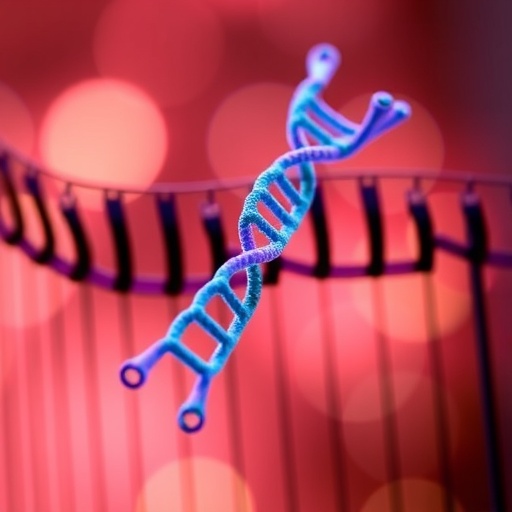In a groundbreaking stride for cancer gene therapy, researchers have unveiled a novel adeno-associated virus (AAV) vector designed specifically for gene replacement therapy targeting NF1-related tumors. This advancement, detailed in a recent publication in Nature Communications, addresses a critical unmet need in treating neurofibromatosis type 1 (NF1), a genetic disorder characterized by the growth of benign tumors along nerves in the skin, brain, and other parts of the body. The newly engineered AAV vector offers promise not only for restoring normal gene function but also for mitigating tumor progression in affected patients.
Neurofibromatosis type 1 stems from mutations in the NF1 gene, which encodes neurofibromin, a tumor suppressor protein. Loss or dysfunction of this gene leads to deregulated cell growth and consequently, tumor formation. For years, therapies have focused mainly on treating tumor symptoms or surgical removal, given the complexity of targeting the gene defect itself. However, the development of this AAV vector marks a paradigm shift, as it enables the direct replacement of a functional NF1 gene in tumor cells, potentially halting tumor development at its root cause.
The design of this vector was no trivial task. The NF1 gene is notably large, creating a significant obstacle for packaging into conventional viral vectors. The research team circumvented this size restriction by innovating an AAV vector capable of efficiently delivering a functional NF1 gene fragment capable of producing a viable and stable neurofibromin protein. Their meticulous engineering ensures the vector’s genome remains within permissible packaging limits while maintaining therapeutic efficacy.
Safety and delivery specificity were paramount in the development process. The team optimized the AAV capsid to enhance its tropism for NF1-related tumor cells, minimizing off-target effects and immune responses. Through surface modifications and capsid engineering, the vector demonstrates preferential entry into Schwann cells and other tumor progenitor cells known to contribute to NF1 tumorigenesis, a critical enhancement that ensures therapeutic payloads reach their intended destinations with high precision.
Preclinical trials involving murine models of NF1 showed encouraging results. Upon intratumoral administration of the AAV vector, researchers observed significant tumor regression and restoration of neurofibromin expression. These findings were corroborated by comprehensive histological analyses and molecular assays, confirming that the vector successfully mediated gene replacement and reactivated downstream pathways involved in controlled cell proliferation and apoptosis.
An equally important facet of the study was the evaluation of immune responses to the therapeutic virus. The AAV vector showcased an attenuated immunogenic profile, critical for enabling sustained expression of the transgene without eliciting destructive immune clearance. Moreover, the vector’s design allows re-administration, offering a potential framework for repeated dosing schedules, a common necessity in chronic genetic conditions like NF1.
Beyond tumor reduction, the therapeutic vector rescued key signaling cascades disrupted by NF1 loss, most notably the Ras-MAPK pathway. By reinstating neurofibromin’s GTPase-activating activity, the therapy normalized aberrant signaling that drives uncontrolled cellular proliferation. This mechanistic insight solidifies the therapy’s dual role—not only halting tumor growth but also restoring intracellular signaling balance indispensable for long-term tumor suppression.
The researchers also tackled the challenge of vector manufacturing and scalability, critical for future clinical translation. They established robust production methods yielding high vector titers with consistent quality. These scalable protocols pave the way for translating this promising preclinical therapy into human trials, moving closer to offering NF1 patients a viable, gene-targeted therapeutic option.
Innovations in vector design extend beyond size accommodation and targeting. The team incorporated regulatory elements that ensure controlled gene expression, preventing potential toxic overexpression of neurofibromin. Such precise regulation mitigates risks of adverse effects associated with gene therapy, elevating the safety profile of the treatment and marking a significant step toward clinical applicability.
Notably, the scalable platform technology developed for this NF1 gene replacement could be a blueprint for addressing other large-gene disorders with similar therapeutic challenges. The combination of precision targeting, safe delivery, and controlled expression holds broad implications, underscoring the vector’s potential beyond neurofibromatosis, possibly extending to other genetic cancers and disorders.
The advent of such vectors aligns with a growing trend of personalized medicine, where gene therapies are tailored to correct specific genetic aberrations. This NF1-targeted approach embodies precision oncology, disrupting tumorigenic processes at the genetic core rather than relying solely on symptomatic treatment. This heralds a shift in treatment paradigms, promising durable responses and improved patient quality of life.
While these findings are a monumental step forward, challenges remain before clinical deployment. Long-term studies are needed to fully elucidate vector persistence, off-target integration risks, and potential immunological complications in humans. Additionally, researchers aim to optimize delivery routes further to address tumors situated in less accessible regions, ensuring comprehensive therapeutic coverage.
The work reflects a close collaborative effort across gene therapy, molecular biology, and clinical oncology disciplines, leveraging multidisciplinary expertise to tackle one of the most elusive genetic tumor conditions. It exemplifies how integrating cutting-edge virology with an in-depth understanding of tumor genetics can lead to transformative therapeutic innovations.
In sum, this pioneering AAV vector development for NF1-related tumor gene replacement therapy opens a thrilling new frontier in cancer genetics. By effectively delivering a functional NF1 gene, the therapy directly addresses the root of tumorigenesis, offering hope for patients who have long faced limited treatment options. As research progresses toward human clinical trials, the promise of a disease-modifying treatment for NF1 shines brighter than ever.
Subject of Research: Neurofibromatosis Type 1 (NF1) gene replacement therapy using adeno-associated virus vectors.
Article Title: Development of an adeno-associated virus vector for gene replacement therapy of NF1-related tumors.
Article References:
Bai, RY., Shi, J., Liu, J. et al. Development of an adeno-associated virus vector for gene replacement therapy of NF1-related tumors. Nat Commun 16, 8594 (2025). https://doi.org/10.1038/s41467-025-63619-4
Image Credits: AI Generated
Tags: AAV vector for gene therapyadvancements in cancer gene therapygene replacement therapy for NF1genetic disorders and tumor growthhalting tumor progression strategiesinnovative approaches to tumor treatmentNature Communications publication on NF1.neurofibromatosis type 1 treatmentneurofibromin tumor suppressor proteinovercoming gene delivery challengesrestoring normal gene functiontargeting NF1-related tumors





